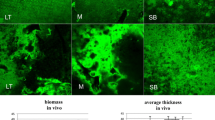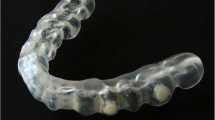Abstract
The aims of the present study were: a) to assess the impact of the intraoral location on the rate of biofilm growth, and b) to establish an in vivo biofilm model to examine intraoral biofilm growth. Eight healthy volunteers wore acrylic splints with 15 glass slabs each in the upper and lower jaws to build up plaque. After 48 h, the specimens were removed and stained using the vital fluorescence technique. Biofilm thickness was evaluated by confocal laser scanning microscopy (CLSM). The mean plaque thickness amounted to 77.6±29.1 µm on the buccal sites of the upper jaw and 71.9±26.3 µm on the buccal sites of lower jaw. On the palatal site a biofilm of 52.1±26.2 µm thickness was grown, which was significantly less compared with the other locations evaluated (p<0.001). The results demonstrate that the in situ biofilm thickness on the buccal sites was similar irrespective of the location in the oral cavity. The new splint system described may be a useful tool for further standardised experimental studies regarding influences on growth and structure of intraoral biofilms.



Similar content being viewed by others
References
Auschill TM, Arweiler NB, Netuschil L, Brecx M, Reich E, Sculean A (2001) Spatial distribution of vital and dead microorganisms in dental biofilms. Arch Oral Biol 46:471–476
Auschill TM, Arweiler NB, Sculean A, Brecx M, Reich E, Netuschil L (2002) The effect of dental restorative materials on dental biofilm. Eur J Oral Sci 110:48–53
Bos R, Van der Mei HC, Buscher HJ (1999) Physico-chemistry of initial microbial adhesive interactions—its mechanisms and methods for study. FEMS Mirocbiol Rev 23:179–230
Bradshaw DJ, Marsh PD, Watson GK, Allison C (1997) Effect of conditioning films on oral microbial biofilm development. Biofoul 11:217–226
Caldwell DE, Korber DR, Lawrence JR (1992) Imaging of bacterial cells by fluorescence exclusion using scanning confocal laser microscopy. J Microbiol Meth 15:249–261
Costerton JW, Lewandowski Z, Caldwell DE, Korber DR (1995) Microbial biofilms. Annu Rev Microbiol 49:711–745
Dibdin GH (1981) Diffusion of sugars and carboxylic acids through dental plaque in vitro. Arch Oral Biol 26:515–524
Furuichi Y, Lindhe J, Ramberg P, Volpe AR (1992) Patterns of de novo plaque formation in the human dentition. J Clin Periodontol 19:423–433
Gilbert P, Das J, Foley I (1997) Biofilm susceptibility to antimicrobials. Adv Dent Res 11:160–167
Guggenheim M, Shapiro S, Gmür R, Guggenheim B (2001) Spatial arrangements and associative behaviour of species in an in vitro oral biofilm model. Appl Environ Microbiol 3:1343–1350
Main C, Geddes DA, McNee SG, Collins WJ, Smith DC, Weetman DA (1984) Instrumentation for measurement of dental plaque thickness in situ. J Biomed Eng 6:151–154
Mandel ID (1974) Relation of saliva and plaque to caries. J Dent Res 53:246–266
Marshall KC (1992) Biofilms: an overview of bacterial adhesion, activity and control at surfaces. Am Soc Microbiol News 58:202–207
McCoy JC, Bryers JD, Robbins J, Costerton JW (1981) Observations in fouling biofilm formation. Can J Microbiol 15:263–276
Netuschil L, Reich E, Brecx M (1989) Direct measurement of the bactericidal effect of chlorhexidine on human dental plaque. J Clin Periodontol 16:484–488
Netuschil L, Reich E, Unteregger G, Sculean A, Brecx M (1998) A pilot study of confocal laser scanning microscopy for the assessment of undisturbed dental plaque. Arch Oral Biol 43:277–285
Nyvad B, Kilian M (1987) Microbiology of early colonisation of human enamel and root surfaces in vivo. Scand J Dent Res 95:369–360
Quirynen M, van Steenberghe D (1989) Is early plaque growth rate constant with time? J Clin Periodontol 16:278–283
Ramberg P, Furuichi Y, Lindhe J, Gaffar A (1992) A model for studying the effects of mouthrinses on de novo plaque formation. J Clin Periodontol 19:509–520
Roberts SK, Bass C, Brading M, Lappin-Scott H, Stoodley P (1999) Biofilm formation and structure: What’s new? In: Newman HN, Wilson M (eds) Dental plaque revisited—oral biofilms in health and disease. BioLine, Cardiff; pp 15–36
Robinson C, Kirkham J, Percival R, Shore RC, Bonass WA, Brookes SJ, Kusa L, Nakagaki H, Kato K, Natress B (1997) A method for the quantitative site specific study of the biochemistry within dental plaque biofilms formed in vivo. Caries Res 31:194–200
Saxton CA (1975) Determination by electron microscope autoradiography of the distribution in plaque of organisms that synthesize intracellular polysaccharide in situ. Caries Res 9:418–437
Shapiro S, Giertsen E, Guggenheim B (2002) An in vitro oral biofilm model for comparing the efficacy of antimicrobial mouthrinses. Caries Res 36:93–100
Singleton S, Treloar R, Warren P, Watson GK, Hodgson R, Allison C (1997) Methods for microscopic characterization of oral biofilms: analysis of colonization, microstructure, and molecular transport phenomena. Adv Dent Res 11:133–149
Sissons CH (1997) Artificial dental plaque biofilm model systems. Adv Dent Res 11:110–126
Sissons CH, Cutress TW, Hoffman MP, Wakefield JSJ (1991) A multi-station dental plaque microcosm (artificial mouth) for the study of plaque growth, metabolism, pH and mineralization. J Dent Res 70:1409–1416
Tatevossian A (1979) Diffusion of radiotracers in human dental plaque. Caries Res 13:154–162
Theilade J (1989) Dental plaque and dental calculus. In Lindhe J (ed): Textbook of clinical periodontology, 2nd edn. Munksgaard, Copenhagen, pp 92–128
Wood SR, Kirkham J, Marsh PD, Shore RC, Nattress B, Robinson C (2000) Architecture of intact natural human plaque biofilms studied by confocal laser scanning microscopy. J Dent Res 79:21–27
Yeganeh S, Lynch E, Jovanovski V, Zou L (1999) Quantification of root surface plaque using a new 3-D laser scanning method. J Clin Periodontol 26:692–697
Zaura-Arite E, ten Cate JM (2000) Effect of fluoride- and chlorhexidine containing varnishes on plaque composition and on demineralisation of dentinal grooves in situ. Eur J Oral Sci 108:154–164
Zaura-Arite E, Van Marle J, ten Cate JM (2001) Confocal microscopy study of undisturbed and chlorhexidine-treated dental biofilm. J Dent Res 80:1436–1440
Acknowledgements
This study was financially supported by a grant from the Deutsche Forschungsgemeinschaft (DFG; Ar 341/1-1). The authors thank Marie Follo, Ph.D., Department of Haematology and Oncology, Core Facility, Albert-Ludwigs-University, Freiburg, Germany for her help in the image analysis.
Author information
Authors and Affiliations
Corresponding author
Rights and permissions
About this article
Cite this article
Auschill, T.M., Hellwig, E., Sculean, A. et al. Impact of the intraoral location on the rate of biofilm growth. Clin Oral Invest 8, 97–101 (2004). https://doi.org/10.1007/s00784-004-0255-6
Received:
Accepted:
Published:
Issue Date:
DOI: https://doi.org/10.1007/s00784-004-0255-6




